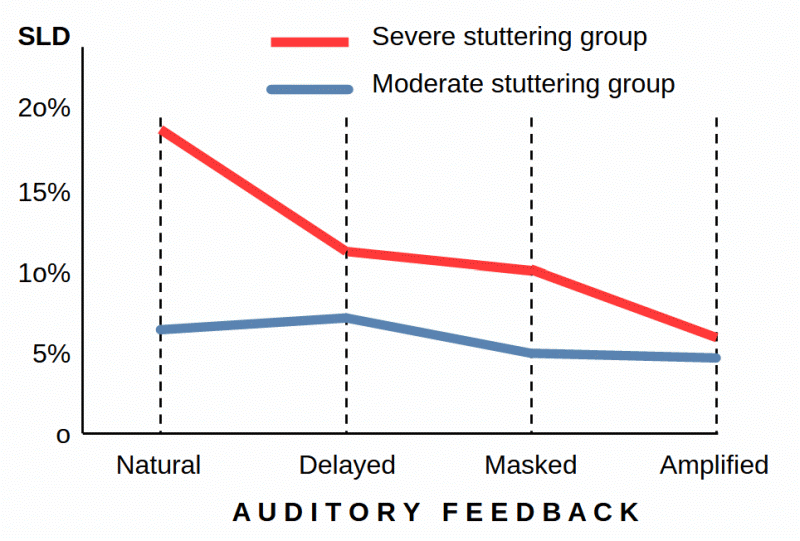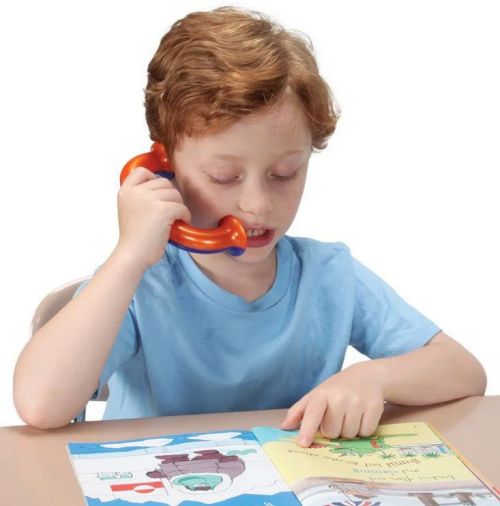 Theory of Stuttering – Blog
Theory of Stuttering – Blog
When the article “Impact of auditory feedback alterations in individuals with stuttering” by Fiorin et al. (2021) was published, I was busy preparing my own paper, and it was the time when my eyesight got dramatically worse. I didn’t yet have the electronic magnifier that now helps me read texts on the screen. So I probably merely read the abstract of the article at that time, and only now did I take a closer look at the data.
The researchers investigated the effect of DAF, auditory masking, and amplified auditory feedback on the spontaneous speech of children and adolescents who stutter, aged 8–17 years. The participants were divided into two groups: a moderate and a severe stuttering group. As was to be expected, DAF and masking noise significantly reduced stuttering, but amplified auditory feedback (65–90 dB according to the maximum comfort level reported by the individual) was most effective.

Figure 21: The diagram corresponds to Fig. 1 in Fiorin et al. (2021); I only simplified and gussied it up a little bit. The reduction of stuttering-like disfluencies (SLD) by amplified auditory feedback was statistically significant in both groups: p = 0.012 (severe) and p = 0.042 (moderate).
This finding is in agreement with the prediction resulting from my theory (Hesse, 2023): if stuttering is caused by insufficient attention to auditory feedback, increased attention to auditory feedback should reduce stuttering. Fiorin and colleagues did not interpret their finding in this way. But unlike DAF and white noise, whose fluency-enhancing effects have often been misunderstood as due to distraction from auditory feedback, amplified auditory feedback through headphones undoubtedly attracts the speaker’s attention. Increased attention to auditory feedback improves its processing and its integration in speech-motor control.
Together, the results of Fiorin and colleagues and those of Lazzari et al. (2024), see below, confirm the three crucial predictions of my stuttering theory: (1) attention to auditory feedback determines its role in motor control; (2) normal speakers automatically pay attention to auditory feedback when generating something audible by movement, but stutterers do not; (3) increased attention to auditory feedback reduces stuttering.
The latter is the most important prediction, as it could be of great relevance for the treatment of stuttering. Therefore, further studies of the effect of amplified auditory feedback (or of other conditions that clearly draw the speaker’s attention to auditory feedback) are necessary.
 A simple way to draw children’s attention to their auditory feedback is the Toobaloo. It is recommended for children who stutter, but to my knowledge, the effect on stuttering has not yet been studied. Given the finding of Fiorin and colleagues, there is a good chance of positive, significant results. This would not only confirm a theoretical prediction, but could also establish the Toobaloo as a tool in stuttering therapy. I would be happy if someone decided to conduct a study like this.
A simple way to draw children’s attention to their auditory feedback is the Toobaloo. It is recommended for children who stutter, but to my knowledge, the effect on stuttering has not yet been studied. Given the finding of Fiorin and colleagues, there is a good chance of positive, significant results. This would not only confirm a theoretical prediction, but could also establish the Toobaloo as a tool in stuttering therapy. I would be happy if someone decided to conduct a study like this.
Different from the study by Fiorin and colleagues, which examined the effects of delayed, masked, and amplified auditory feedback, the proposed study should not (or not alone) test the efficacy of the Toobaloo, but rather the effect of increased attention to auditory feedback. That is, participants should be instructed to attentively listen to their voice when using the Toobaloo. To focus attention more safely on auditory feedback, it may be good to use two Toobaloos, one for each ear.
The core of my stuttering theory is that stuttering occurs because too little attention is directed to the auditory feedback of speech, and too much to speech planning, motor control (the sensory feedback of articulatory movements), emotions, and other things. The theory implies that the attention system in non-stutterers is more stable and ensures that auditory feedback is always automatically involved in speech-motor control.
It is thus not surprising that I was happy to read the article “Subtle patterns of altered responsiveness to delayed auditory feedback during finger tapping in people who stutter” by Giorgio Lazzari, Robert van de Vorst, Floris von Vugt, and Carlotta Lega. Their most important finding is that stutterers could, but non-stutterers could not disregard auditory feedback in a finger-tapping task.
In the study, stutterers and normally fluent controls performed a synchronization-continuation finger-tapping task. They aligned their tapping to the clicking of a metronome and continued tapping in that rhythm after the metronome signal was switched off. The auditory feedback of the tapping was presented through headphones, with various delays. In one of the experimental conditions, the participants were instructed to ignore auditory feedback,
The result was, that the controls, despite the instruction, could not disregard auditory feedback, even though it was irrelevant to the task. The feedback delay affected their motor performance; they had difficulty maintaining the rhythm. By contrast, the stutterers could better ignore auditory feedback; they maintained consistent motor performance across different delay levels.
No doubt, Lazzari and colleagues investigated the role of auditory feedback in a non-verbal sensorimotor task in order to learn something about the role that auditory feedback probably plays in speaking in stutterers and non-stutterers. Even though the finding that non-stutterers could not ignore auditory feedback was unexpected—the authors perhaps expected a disability to align their tapping to auditory feedback among the stutterers—we can most likely apply the result to speaking.
Normal speakers automatically pay attention to auditory feedback—they cannot ignore it. This ensures that auditory feedback is well involved in speech-motor control. By contrast, stutterers can ignore auditory feedback, and they often do so when speaking; they instead focus much on speech planning and/or the sensory feedback of articulatory movements. This results in poor auditory-motor integration and stuttering.
That stutterers ignore auditory feedback when speaking is also suggested by neurological findings: (1) by lack of activation in the posterior superior temporal cortex during speech compared to normally fluent speakers (see Table 1) and (2) by the correlation (found in normal speakers) between attention to auditory speech stimuli and activation in those cortical areas (Jäncke, Mirzazade, & Shah, 1999; Hugdal et al., 2003; Sabri et al., 2008).
The authors conclude that stutterers differ from normal speakers “in specific subcomponents of sensorimotor integration mechanisms.” That’s correct if we consider attention to auditory feedback a subcomponent of the auditory-motor integration mechanism. An important, although not surprising, result of the study is: whether auditory feedback is involved in motor control depends on attention to auditory feedback. Not a few researchers have assumed that stuttering results from poor auditory-motor integration, but the relationship between attention to auditory feedback and auditory-motor integration has been largely overlooked until now.
In an experimental condition, in which participants were instructed to pay attention to auditory feedback and to align it in time with the metronome signal, there was no difference in performance between stutterers and controls; auditory feedback was involved in motor control. By contrast, when the stutterers ignored auditory feedback, it did not affect motor control. We can thus conclude, at least for the stuttering group, that attention to auditory feedback determined auditor-motor integration.
I think that, in the synchronization-continuation finger-tapping task, the delay of auditory feedback played no role other than to help discover that the controls couldn’t ignore auditory feedback (delayed or not), but the stutterers could; there is no direct relationship to the (seemingly opposed) effects of DAF on stutterers and non-stutterers when speaking (see below).
To summarize, the evidence that (1) non-stutterers cannot ignore auditory feedback, but stutterers can, and that (2) attention to auditory feedback determines whether it is involved in motor control are valuable pieces of the puzzle that we must put together to reveal the causes of stuttering.
The delay time best for reducing stuttering is 50–75 ms (Armson & Kiefte, 2008; Kalinowski et al., 1996; Lincoln, Packman, & Onslow, 2006). Such a short delay of auditory feedback hardly evokes disfluencies in normal speakers (Foundas et al., 2004a, 2013; Stuart et al., 2002); even a delay of 120 ms has little effect on normal speakers (Foundas et al., 2004a). However, it sounds unfamiliar and attracts attention; stutterers no longer ignore the auditory feedback of their speech. This improves auditory-motor integration and reduces stuttering.
DAF can also cause disfluencies in normal speakers, the so-called Lee effect (Lee, 1951). The delay time maximally disrupting for normal speakers is about 200 ms (Fairbanks & Guttman, 1958; Stuart et al., 2002). Such a long delay probably disturbs self-monitoring and auditory-motor integration, which manifests in prolonged speech, repetitions, and other, not stuttering-like, errors. This is the case not only with normal speakers, but also with stutterers (Hayden, Scott, & Addicott, 1977). Stutterers may be better able to ignore such adverse DAF and instead focus on the kinesthetic and tactile feedback of their articulatory movements. But in those studies, they were not instructed to ignore the DAF.